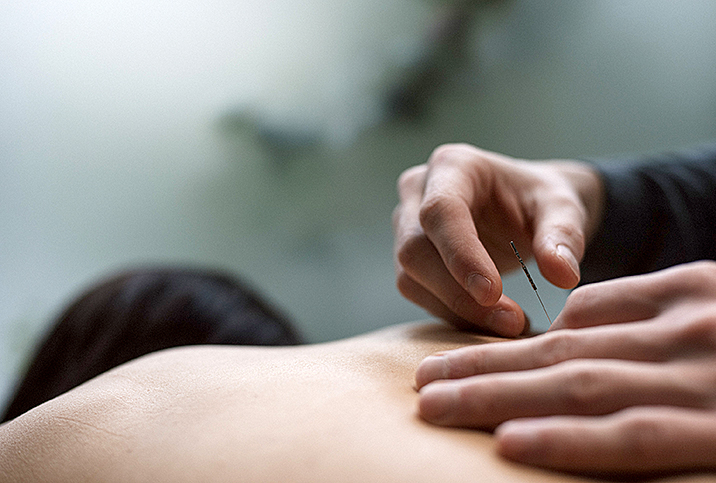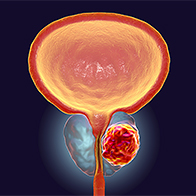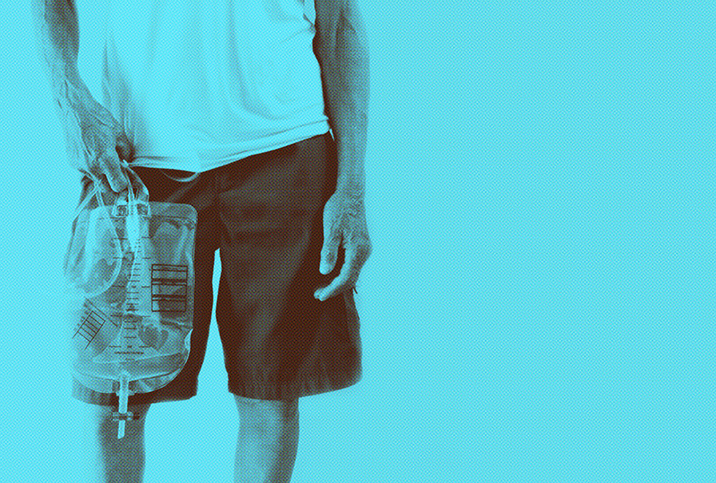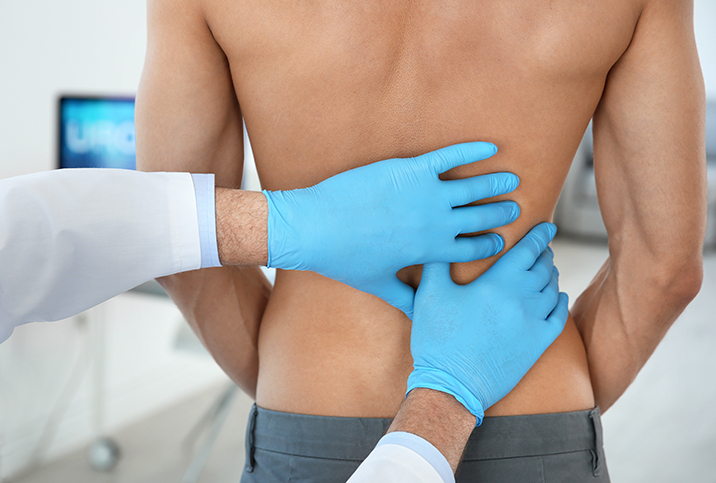Acupuncture Shows Promise for Prostatitis Pain

Acupuncture has long been widely touted as a natural, effective treatment for various types of chronic pain and inflammation. But let's face it: A lot of people probably wonder how inserting a bunch of needles into your body can possibly cure anything, let alone a chronic condition.
But a new study is sticking it to naysayers. Acupuncture may provide relief for men with chronic prostatitis pain, according to clinical trial results published in August 2021 in the Annals of Internal Medicine. Researchers found 20 sessions of acupuncture diminished symptoms in 61 percent of participants, compared to 37 percent of participants who improved while receiving "sham" acupuncture. (The authors explained that sham therapy might have caused some physiological effects.) The benefits remained six months after acupuncture treatment ended.
Additionally, a 2018 study review indicated acupuncture can likely decrease chronic prostatitis/chronic pelvic pain syndrome symptoms, helping patients avoid potential side effects of drug treatments. The latest study indicates these results are sustainable.
"Chronic prostatitis affects a large number of adult men under 50 around the world and greatly impacts their physical and psychological health," said Zhishun Liu, M.D., Ph.D., senior researcher on the 2021 clinical trial and director of the acupuncture department at Guang'anmen Hospital in Beijing. "There is still a lack of effective therapy due to the complex and unclear etiology of it. However, acupuncture has potential in the treatment of pelvic disorders."
What is prostatitis?
Prostatitis, an inflammatory condition that affects the prostate gland and nearby nerves and tissues, can cause discomfort and pain in the groin, difficulty urinating, painful urination and ejaculation, and flu-like symptoms. Many people with the condition experience psychological effects, such as depression.
"Prostatitis literally means prostate inflammation," said Marc S. Cohen, M.D., a Sarasota, Florida-based urologist and Bastion Health medical advisor. "In many ways, it is a dated term, as what has once been thought a bacterial infection of the prostate is much more enigmatic with multiple contributing etiologies, many of which are poorly understood."
About 10 percent of prostatitis cases are caused by bacterial infections, which antibiotics can resolve. However, more than 90 percent of the time, the disease's cause is unknown. These cases, referred to as chronic nonbacterial prostatitis/chronic pelvic pain syndrome (CP/CPPS), affect about 10 percent to 15 percent of American males, according to the National Institute of Diabetes and Digestive and Kidney Disorders. In these instances, typical anti-inflammatory painkillers often fall short of a resolution.
More than 90 percent of the time, the disease's cause is unknown.
"Prostatitis due to a bacterial infection is easy to diagnose with urine tests and easy to treat with antibiotics. Nonbacterial prostatitis is inflammation of the prostate that causes pain, which is not due to a bacterial infection," said David Yao, M.D., attending urologist at the David Geffen School of Medicine at the University of California, Los Angeles. "Prostatitis symptoms do not always involve the prostate, and the problem may be from nearby tissues. Nonbacterial prostatitis may be linked to stress, nerve irritation, urinary tract injury or a reaction to a previous infection."
Yao went on to list other possible causes for this type of pain: pelvic muscle tightness, prostate or bladder stones, benign prostatic hypertrophy, urethral stricture, prostate cancer and bladder cancer.
Often, however, doctors are unable to nail down the root cause of the prostatitis symptoms. But Yao wants everyone to know prostatitis is not a sexually transmitted disease (STD) and does not increase the risk of prostate cancer.
Treatment options for prostatitis
Prostatitis treatment varies depending on the cause (if determined), severity and symptoms. Patients often experience the best results when using multiple treatments simultaneously.
"Due to the multiple possible causes for chronic prostatitis, the diagnosis and treatment of this are often complex, time-consuming and challenging for both the patient and even the most experienced physician," Yao said. "Sometimes, there is no effective treatment that we can offer."
Besides anti-inflammatories and other medicines to reduce nerve pain, Yao said treatment for nonbacterial prostatitis usually involves alpha blockers to relax the muscles around the prostate and the bladder base. Doctors may also recommend prostate massage to relieve pressure by draining fluid from the prostate ducts, and pelvic floor physical therapy to relax certain muscles and ease tension from the pelvic floor.
Other means to reduce inflammation and pressure include a prostatitis pillow, hot baths, hot-water bottles and heating pads. Lifestyle changes, such as attaining a healthy weight, reducing stress and eating a prostate-friendly diet (including eliminating alcohol, caffeine and spicy or acidic foods), can help, too.
Alternative therapies such as acupuncture/acupressure, and mind-body interventions such as yoga and meditation, can be part of a well-rounded treatment arsenal, according to Cohen.
"Because of the benefits of acupuncture realized in other chronic pain circumstances, such as back pain, it is gratifying to see that similar benefits could be realized in CPPS associated with pain," Cohen said.
How acupuncture works
Acupuncture involves inserting fine needles into the skin at strategic points in the body. Traditionally, it is thought to alter energy flow, or qi, pronounced "chee." Scientific research suggests it stimulates the central nervous system, prompting the release of chemicals responsible for fighting inflammation and alleviating pain.
According to Liu, it's unclear why acupuncture has lasting effects on chronic prostatitis symptoms.
"The mechanism is complex and not very clear," Liu said. "Stimulation of acupuncture can promote the release of central opioid peptides [enkephalins, endorphins and dynorphins] into the blood, which produces analgesic effects and induces a feeling of euphoria. It can also inhibit cyclooxygenase synthesis in peripheral and central nociceptive sites."
The positive effects likely boil down to acupuncture's ability to reduce inflammation, which is the problem caused by prostatitis.
"Acupuncture has been shown to break up the 'cytokine storm,' compounds generated in acute and chronic inflammatory conditions," explained Tom Ingegno, D.A.C.M., a licensed acupuncturist and the owner of Charm City Integrative Health in Baltimore. "One of the many reasons it can do this is because it causes vasodilation both locally [to where the needles are placed] and systemically. With the blood vessels open, inflammatory compounds, like cytokines and 'stagnant blood' which is low in oxygen and nutrients, get flushed out of the area."
Fresh blood, which is richer in oxygen and nutrients, then floods the area and promotes healing and reduces pain and inflammation.
"Since this action is systemic and not specific to one type of tissue or symptom, it can be used to reduce the pain, increase urinary output and reduce swelling of the prostate," Ingegno said.
Inflammation is not always harmful. It is an immune system response that can safeguard an injured area and kick-start the healing process. Inflammation usually dissipates on its own. But when it doesn't, myriad issues can arise, among them chronic pain.
Ingegno used the example of bumping your shin on the coffee table. You get a bruise. Why? Some of the capillaries rupture and swelling results, which is inflammation. As the tissue heals, the swelling goes away.
"During this period of acute trauma, the inflammation presses on nerves that cause pain," he said. "In chronic inflammatory issues—think anything ending in -itis [e.g., arthritis, bronchitis]—the inflammatory process doesn't 'turn off,' leaving the tissue swollen and painful."
That's where acupuncture comes in.
The prostatitis/acupuncture study
Liu and his colleagues at 10 hospitals in China studied 440 men ages 18 to 50 with chronic prostatitis and no evidence of bacterial infection. Half of the participants were assigned to receive 20 acupuncture sessions in an eight-week span. The other half were assigned to receive a sham procedure involving the insertion of needles superficially, away from pertinent acupoints.
After eight weeks, researchers scored the participants based on an index of multiple chronic prostatitis symptoms. They found 61 percent of participants in the acupuncture group responded positively, dropping at least six points on the index. The participants continued to report positive results six months later.
The findings indicate acupuncture produced significant improvement in people with moderate to severe CP/CPPS, Liu said, with "durable effects" 24 weeks after treatment.
"The results of our trial indicate that the efficacy of acupuncture can be sustained at least six months after the treatment stopped," Liu said.
According to Ingegno, although patients may experience relief within a few acupuncture sessions, ongoing treatment may be necessary to sustain results.
"With chronic prostatitis, the patients are generally older and have more complaints than just pain or difficulty urinating," he said. "These patients see slow and steady progress. In this case, depending on the underlying cause, the patient may fully recover or need maintenance treatments to keep the symptoms under control."
Ingegno pointed out that acupuncture is therapy, like massage, chiropractic, physical therapy and others. Some people may see results after one visit; most won't. They'll require a course of treatment, the duration of which depends on the condition's severity, the patient's overall health and whether they are employing any other interventions that may work with the acupuncture.
Although Liu said acupuncture can be recommended to patients in clinical practice, the long-term efficacy of the treatment for chronic prostatitis is unknown and requires further study. More research is also needed, he said, to assess the effects of acupuncture on broader demographics and to identify characteristics of those patients most likely to benefit.




















